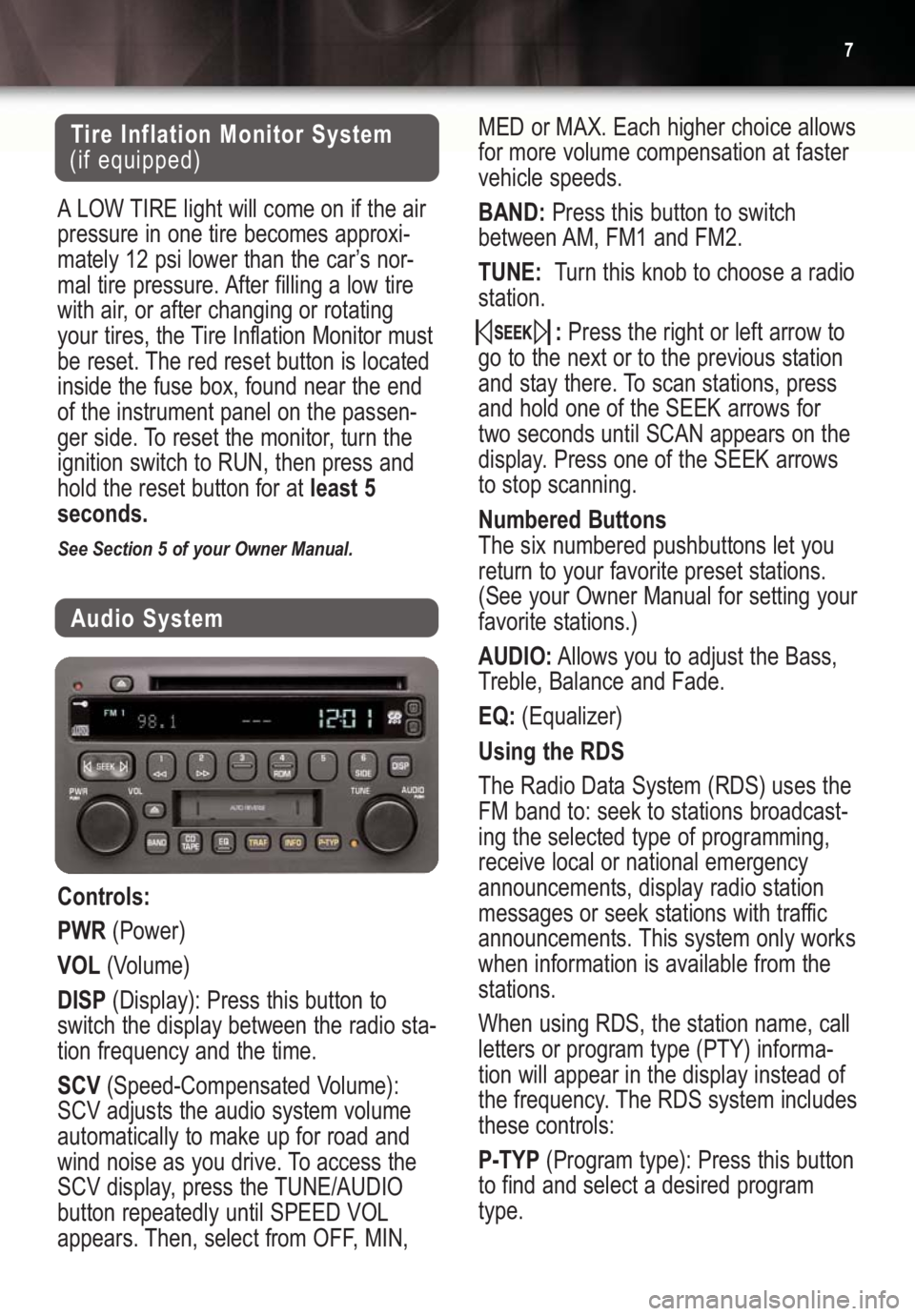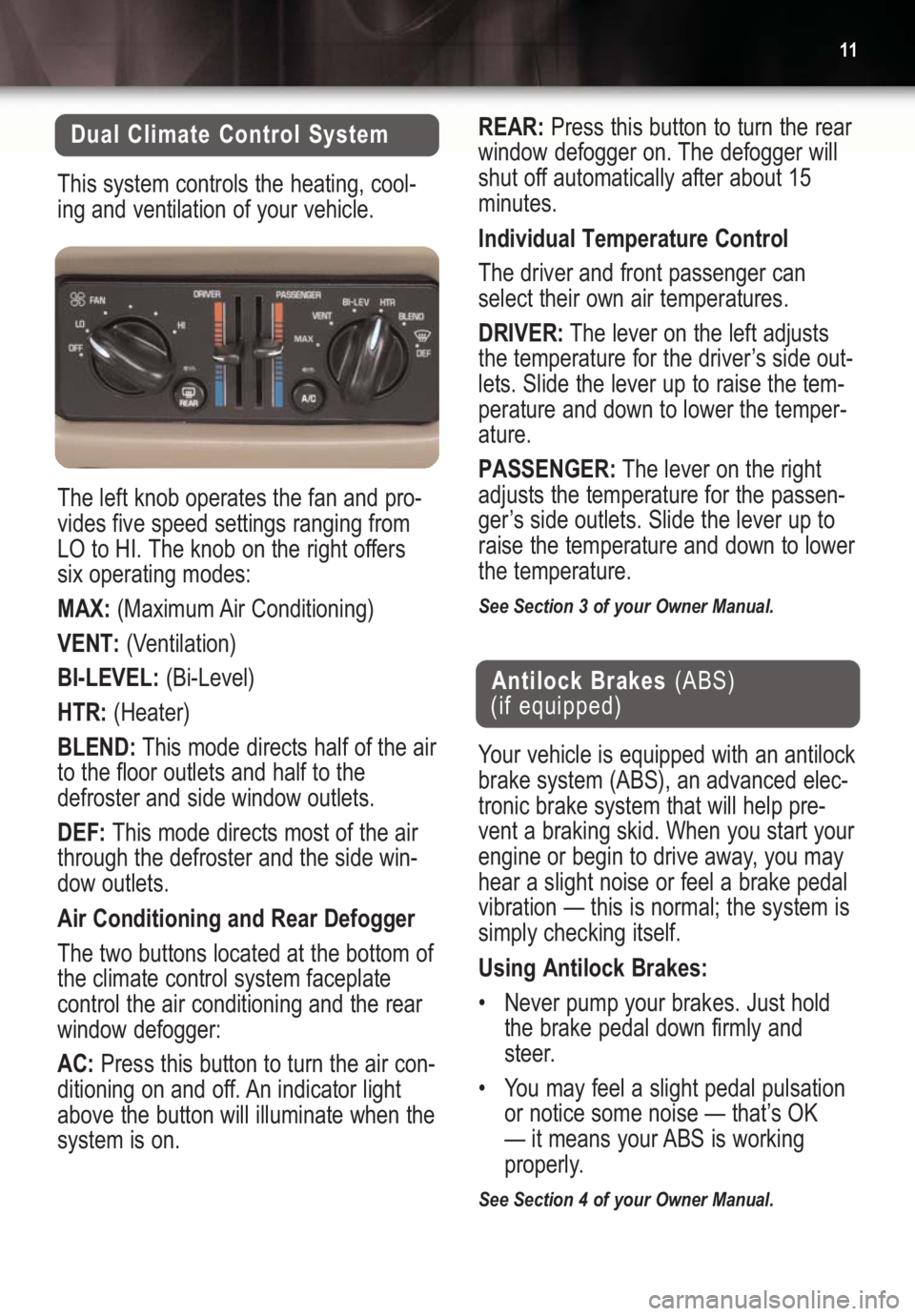buttons BUICK CENTURY 2004 Get To Know Guide
[x] Cancel search | Manufacturer: BUICK, Model Year: 2004, Model line: CENTURY, Model: BUICK CENTURY 2004Pages: 12, PDF Size: 0.32 MB
Page 7 of 12

7
Audio System
Controls:
PWR(Power)
VOL(Volume)
DISP(Display): Press this button to
switch the display between the radio sta-
tion frequency and the time.
SCV(Speed-Compensated Volume):
SCV adjusts the audio system volume
automatically to make up for road and
wind noise as you drive. To access the
SCV display, press the TUNE/AUDIO
button repeatedly until SPEED VOL
appears. Then, select from OFF, MIN,
Tire Inflation Monitor System
(if equipped)
ALOW TIRE light will come on if the air
pressure in one tire becomes approxi-
mately 12 psi lower than the car’s nor-
mal tire pressure. After filling a low tire
with air, or after changing or rotating
your tires, the Tire Inflation Monitor must
be reset. The red reset button is located
inside the fuse box, found near the end
of the instrument panel on the passen-
ger side. To reset the monitor, turn the
ignition switch to RUN, then press and
hold the reset button for at least 5
seconds.
See Section 5 of your Owner Manual.
MED or MAX. Each higher choice allows
for more volume compensation at faster
vehicle speeds.
BAND:Press this button to switch
between AM, FM1 and FM2.
TUNE:Turn this knob to choose a radio
station.
:Press the right or left arrow to
go to the next or to the previous station
and stay there. To scan stations, press
and hold one of the SEEK arrows for
two seconds until SCAN appears on the
display. Press one of the SEEK arrows
to stop scanning.
Numbered Buttons
The six numbered pushbuttons let you
return to your favorite preset stations.
(See your Owner Manual for setting your
favorite stations.)
AUDIO:Allows you to adjust the Bass,
Treble, Balance and Fade.
EQ:(Equalizer)
Using the RDS
The Radio Data System (RDS) uses the
FM band to: seek to stations broadcast-
ing the selected type of programming,
receive local or national emergency
announcements, display radio station
messages or seek stations with traffic
announcements. This system only works
when information is available from the
stations.
When using RDS, the station name, call
letters or program type (PTY) informa-
tion will appear in the display instead of
the frequency. The RDS system includes
these controls:
P-TYP(Program type): Press this button
to find and select a desired program
type.
Page 11 of 12

11
Dual Climate Control System
This system controls the heating, cool-
ing and ventilation of your vehicle.
The left knob operates the fan and pro-
vides five speed settings ranging from
LO to HI. The knob on the right offers
six operating modes:
MAX:(Maximum Air Conditioning)
VENT:(Ventilation)
BI-LEVEL:(Bi-Level)
HTR:(Heater)
BLEND:This mode directs half of the air
to the floor outlets and half to the
defroster and side window outlets.
DEF:This mode directs most of the air
through the defroster and the side win-
dow outlets.
Air Conditioning and Rear Defogger
The two buttons located at the bottom of
the climate control system faceplate
control the air conditioning and the rear
window defogger:
AC:Press this button to turn the air con-
ditioning on and off. An indicator light
above the button will illuminate when the
system is on.REAR:Press this button to turn the rear
window defogger on. The defogger will
shut off automatically after about 15
minutes.
Individual Temperature Control
The driver and front passenger can
select their own air temperatures.
DRIVER:The lever on the left adjusts
the temperature for the driver’s side out-
lets. Slide the lever up to raise the tem-
perature and down to lower the temper-
ature.
PASSENGER:The lever on the right
adjusts the temperature for the passen-
ger’s side outlets. Slide the lever up to
raise the temperature and down to lower
the temperature.
See Section 3 of your Owner Manual.
Antilock Brakes (ABS)
(if equipped)
Your vehicle is equipped with an antilock
brake system (ABS), an advanced elec-
tronic brake system that will help pre-
vent a braking skid. When you start your
engine or begin to drive away, you may
hear a slight noise or feel a brake pedal
vibration — this is normal; the system is
simply checking itself.
Using Antilock Brakes:
•Never pump your brakes. Just hold
the brake pedal down firmly and
steer.
•You may feel a slight pedal pulsation
or notice some noise — that’s OK
— it means your ABS is working
properly.
See Section 4 of your Owner Manual.